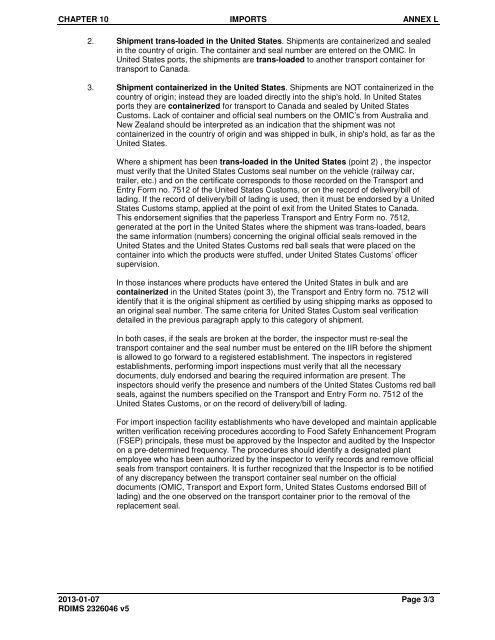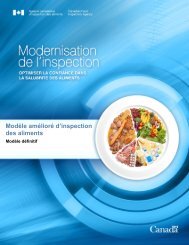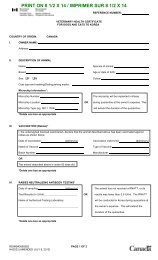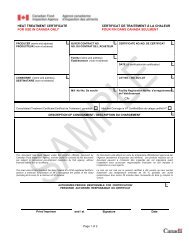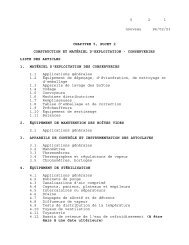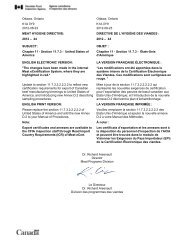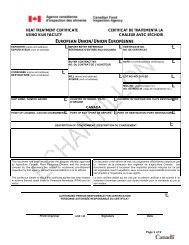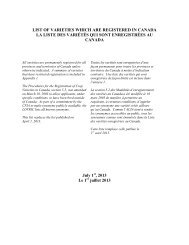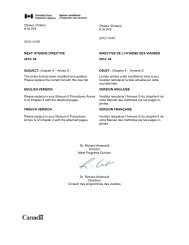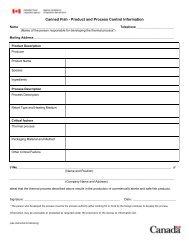PDF (342 kb ) - Agence canadienne d'inspection des aliments
PDF (342 kb ) - Agence canadienne d'inspection des aliments
PDF (342 kb ) - Agence canadienne d'inspection des aliments
Create successful ePaper yourself
Turn your PDF publications into a flip-book with our unique Google optimized e-Paper software.
CHAPTER 10 IMPORTS ANNEX L2. Shipment trans-loaded in the United States. Shipments are containerized and sealedin the country of origin. The container and seal number are entered on the OMIC. InUnited States ports, the shipments are trans-loaded to another transport container fortransport to Canada.3. Shipment containerized in the United States. Shipments are NOT containerized in thecountry of origin; instead they are loaded directly into the ship's hold. In United Statesports they are containerized for transport to Canada and sealed by United StatesCustoms. Lack of container and official seal numbers on the OMIC’s from Australia andNew Zealand should be interpreted as an indication that the shipment was notcontainerized in the country of origin and was shipped in bulk, in ship's hold, as far as theUnited States.Where a shipment has been trans-loaded in the United States (point 2) , the inspectormust verify that the United States Customs seal number on the vehicle (railway car,trailer, etc.) and on the certificate corresponds to those recorded on the Transport andEntry Form no. 7512 of the United States Customs, or on the record of delivery/bill oflading. If the record of delivery/bill of lading is used, then it must be endorsed by a UnitedStates Customs stamp, applied at the point of exit from the United States to Canada.This endorsement signifies that the paperless Transport and Entry Form no. 7512,generated at the port in the United States where the shipment was trans-loaded, bearsthe same information (numbers) concerning the original official seals removed in theUnited States and the United States Customs red ball seals that were placed on thecontainer into which the products were stuffed, under United States Customs’ officersupervision.In those instances where products have entered the United States in bulk and arecontainerized in the United States (point 3), the Transport and Entry form no. 7512 willidentify that it is the original shipment as certified by using shipping marks as opposed toan original seal number. The same criteria for United States Custom seal verificationdetailed in the previous paragraph apply to this category of shipment.In both cases, if the seals are broken at the border, the inspector must re-seal thetransport container and the seal number must be entered on the IIR before the shipmentis allowed to go forward to a registered establishment. The inspectors in registere<strong>des</strong>tablishments, performing import inspections must verify that all the necessarydocuments, duly endorsed and bearing the required information are present. Theinspectors should verify the presence and numbers of the United States Customs red ballseals, against the numbers specified on the Transport and Entry Form no. 7512 of theUnited States Customs, or on the record of delivery/bill of lading.For import inspection facility establishments who have developed and maintain applicablewritten verification receiving procedures according to Food Safety Enhancement Program(FSEP) principals, these must be approved by the Inspector and audited by the Inspectoron a pre-determined frequency. The procedures should identify a <strong>des</strong>ignated plantemployee who has been authorized by the inspector to verify records and remove officialseals from transport containers. It is further recognized that the Inspector is to be notifiedof any discrepancy between the transport container seal number on the officialdocuments (OMIC, Transport and Export form, United States Customs endorsed Bill oflading) and the one observed on the transport container prior to the removal of thereplacement seal.2013-01-07 Page 3/3RDIMS 2326046 v5


